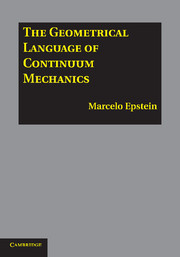Appendix A - A Primer in Continuum Mechanics
Published online by Cambridge University Press: 05 August 2011
Summary
The principal aim of this book is to emphasize the geometric structure of Continuum Mechanics, but a reader not familiar with the by now standard presentation of this discipline is likely to miss the punch line. In part to avoid this unintended situation and in part to have a basic conceptual and terminological framework for the rest of the book, in this Appendix we provide a concise presentation of the subject as it can be found in more or less standard elementary textbooks. The level of mathematical sophistication is kept as low as possible: vectors are arrows, Pythagoras reigns supreme, everything is nice and smooth.
Bodies and Configurations
The passage from the classical mechanics of finite systems of particles and rigid bodies to the mechanics of deformable continua is not a trivial one. Already at the beginning of the subject we find ourselves confronted with the problem of defining the main concept: the body, or material continuum. Is it merely an infinite collection of particles? Because we must, at the very least, be able to define fields (temperature, velocity, and so on) over this entity, it is clear that we need a rigorous definition. This need is all the more pressing since, from our experience with centuries-old particular theories (hydrodynamics, linear elasticity, and so on), we know that soon enough temporal and spatial derivatives of these fields will enter the scene.
- Type
- Chapter
- Information
- The Geometrical Language of Continuum Mechanics , pp. 274 - 305Publisher: Cambridge University PressPrint publication year: 2010
- 1
- Cited by



